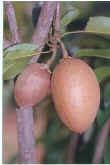Sapota varieties

Sapota takes around 200 days to mature from fruit set. Arrest of latex flow and change in fruit surface colour (potato colour) are the best maturity indices for sapota fruits.
Several
traditional varieties are grown in
1. Cricket Ball: Also known as ‘Calcutta Large’ bears large round fruits. The pulp is gritty and granular and moderately sweet.
2. Kalipatti: It is the leading variety in Maharashtra, Gujarat and
North Karnataka . It has dark green broad and thick
leaves. Fruits are oval shaped with sweet pulpy pulp.
3. Pala: It is a popular variety in Andhra Pradesh and Tamil Nadu. The fruits are small to medium with oval or egg shape borne in clusters.
4. Kirthibarti: A popular variety in Andhra Pradesh. Fruits are medium sized, oval and peel is rough and thick.
5. Baramasi: A popular variety in West Bengal,Bihar and
Uttar Pradesh. The fruits are medium sized and partially round.
6. Pilipatti: This variety has unique small fruits found in Maharashtra and
Gujarat . The fruits are oblong, elongated with soft
sweet pulp.
7. Gutthi: The fruits are small sized and oval in shape, with apex broadly pointed. Pulp is very sweet and fruits are borne in clusters.
8. Jonnavalasa: This variety if from Andhra Pradesh has medium to large ovate fruits with light coloured peel and pulp which is sweet.
Some improved varieties / hybrids have also been released:
1. CO 1: Hybrid released from TNAU Coimbatore in 1972, a cross between Cricket Ball x Oval, has big long oval fruit. Flesh is granular and sweet.
2. CO 2: A clonal selection from the cultivar Baramasi, with round fruits, soft and juicy. This was released from TNAU Coimbatore in 1974.
3. CO 3: A hybrid of Cricket Ball x Vavilavalasa released in the year 2000. It is a medium sized tree with high yield which can produce fruits all through the year.
4. PKM-1: This is a clonal selection from the cutivar Gutthi released from Periyakulam in the year 1981. The plants are dwarf with round and oval fruits, thin peel, soft pulp, very sweet. A high yielder with medium sized fruits but has poor keeping quality.
5. PKM-2: Is a hybrid of Gutti x Kirtibarti released for high yield from Periakulam in the year 1992. The fruits are oblong and oval which has better quality than PKM-1.
6. PKM-3: Also released from Periyakulam in the year 1994. Is a hybrid of Gutti x Cricket Ball cultivars. The fruits are produced in clusters, oval large, early maturing and tolerant to leaf spot and leaf webber.
7. PKM-4: A cultivar released in the year 2003 is a selection from open pollinated progeny. The fruit is of spindle shape which is suited for high density planting.
8. PKM-5: Released in 2007, it is a selection from open pollinated seedlings maintained in a
private orchard at Virudhunagar. High yielder, High Total Soluble
Solids (25.50 brix) and suitable for preparation of dry flakes, milk
shake powder and mixed fruit jam. Oval shaped attractive fruits with
smooth, light brown skin which facilitates a good market appeal.
Flesh is crisp and retains coppery brown colour while other sapota
varieties turn dark brown after ripening.
pollinated seedlings maintained in a
private orchard at Virudhunagar. High yielder, High Total Soluble
Solids (25.50 brix) and suitable for preparation of dry flakes, milk
shake powder and mixed fruit jam. Oval shaped attractive fruits with
smooth, light brown skin which facilitates a good market appeal.
Flesh is crisp and retains coppery brown colour while other sapota
varieties turn dark brown after ripening.
9. DHS-1: A hybrid of Kalipatti x Cricket Ball, released from UAS, Dharwad in the year 1991. It is a vigorous growing plant with round to oblong fruits, high yield, sweet, soft granular mellowing pulp.
10
. DHS-2: Another hybrid from the above cross Kalipatti x Cricket Ball also released from UAS, Dharwad in the year 1991. This has bigger fruits than DHS-1, which is round in shape.